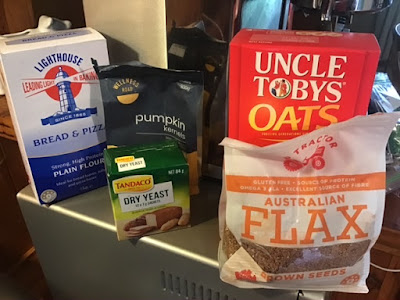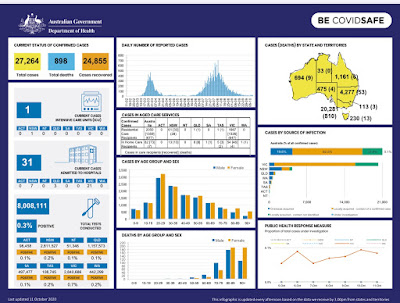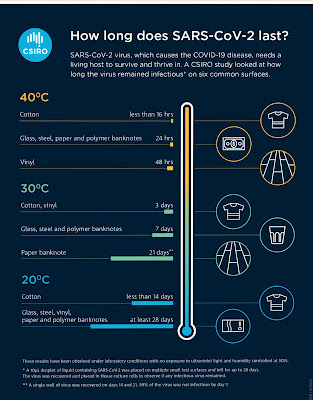While the Covid second wave surges across Europe and the first wave relentlessly continues in the USA, our figures, though still concerning, have stabilized.
The state of Victoria still has the highest incidence of cases but nowhere near the peak of their second wave.
It recorded 15 new cases yesterday with no deaths.
NSW advised one new local case in the latest 24 hour reporting period. The state recorded six cases in total, five of which were detected in overseas travellers in hotel quarantine.
Queensland has recorded zero new cases overnight, maintaining the active cases in the state to four.
All other states and territories report zero cases of community transmission.
Melbourne, Victoria's capital has been easing its lockdown for the past several weeks following a decline in cases. But Victoria's Premier Daniel Andrews says the number of new cases is
not yet falling fast enough to ease all of the restrictions that were
promised.
Queensland's border with New South Wales is still yet to open.
Western Australia's borders are closed to the rest of Australia and not expected to be open until April 2021.
The Prime Minister has confirmed Australia will move “very cautiously” to reopen
international quarantine-free travel with a “handful” of countries (New Zealand, Japan, Singapore and South Korea), raising the
prospect Europe and the United States will be excluded until 2022 unless
a Covid vaccine is available.
Meanwhile our government research organization. the CSIRO, has published new research which shows COVID-19 can last up to 28 days on surfaces like mobile phone and ATM screens.
This is much longer than previously thought.
They conducted the experiment at three different temperatures, 20°C, 30°C and 40°C, with the relative humidity kept at 50%. The surfaces used in the study were stainless steel, glass, vinyl, paper and polymer banknotes, and cotton cloth. These are examples of high contact surface areas such as glass on touchscreens and stainless steel doorknobs.
At 20°C, the virus was extremely robust. They were able to recover infectious material after 28 days from the smooth (non-porous) surfaces. These are stainless steel, glass, vinyl and paper and polymer banknotes.
The length of time infectious virus was able to survive on the porous material (cotton cloth) was much shorter. On cloth, they were unable to detect any viable virus past 14 days.
At 30°C infectious virus did not survive beyond seven days on stainless steel, money (polymer banknotes) and glass. However, on vinyl and cotton cloth, infectious material was not detectable beyond three days.
At 40°C virus was inactivated much faster. Infectious SARS-CoV-2 was detectable for less than 16 hours for cotton cloth. While on glass, paper and polymer notes, and stainless steel it was detectable for up to 24 hours, and 48 hours for vinyl.
So guess the lesson here is keep washing and/or disinfecting your hands, don't touch you face and of course wear a mask when social distancing is not possible or practical.































